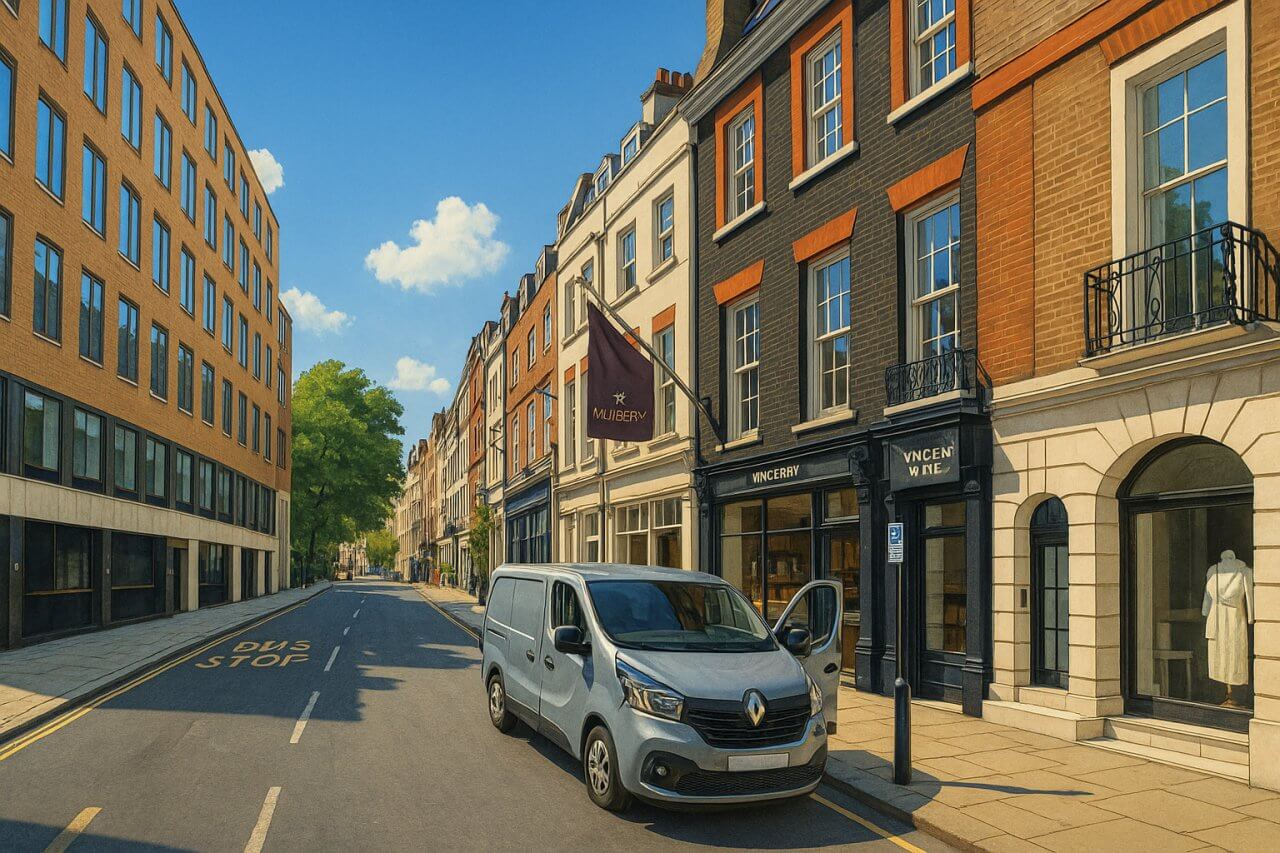
Bruton Street, London
Bruton Street is a refined and historic thoroughfare in the heart of Mayfair, City of Westminster, linking the fashion destination of New Bond Street to the genteel greenery of Berkeley Square. Its discreet elegance and significant heritage make it a standout among the quiet enclaves of central London.
Location and Layout
Bruton Street runs in a gentle curve from the northwestern corner of Berkeley Square to the intersection with New Bond Street. It is approximately 290 metres (950 feet) in length. The road is a two-way street for much of its length, though parts of it include narrower sections that are effectively managed as single-lane with traffic calming in place. Side streets such as Bruton Place, Bruton Lane and Barlow Place branch off it, adding a quiet mews character to the area.
Origins of the Street Name
The street name derives from the Somerset town of Bruton, historically associated with the Berkeley family, who owned land in this part of London during the development of Mayfair in the early 18th century. The name is pronounced ‘Brew-ton’, IPA: /ˈbruːtən/  .
.
Historical Background
Bruton Street was laid out in the early 1700s as part of the westward expansion of London's upper-class residential neighbourhoods. It developed in tandem with the rest of Mayfair, which became fashionable among the aristocracy following the decline of St James's as the centre of courtly life. The street's proximity to Berkeley Square and New Bond Street made it a desirable location for elegant townhouses and later, exclusive boutiques and private clubs.
Character and Appearance
Today, Bruton Street retains much of its original character. It is lined with a mix of Georgian facades, Edwardian townhouses, luxury boutiques, and offices catering to art dealers and fashion brands. Despite its central location, the street maintains a relatively low level of foot traffic compared to nearby commercial streets, giving it a refined and exclusive feel. Bruton Place, a narrow mews alley that runs parallel, enhances the intimacy of the area.
Notable Sights and Connections
Berkeley Square
At its western end, Bruton Street opens into Berkeley Square, a historic green space lined with mature London plane trees and surrounded by stately townhouses. The square is home to several private clubs, embassies, and fine dining establishments. It is also famously haunted, according to London legend, by a ghost at No. 50.
Queen Elizabeth II's Birthplace
One of the most famous associations with Bruton Street is that it was the birthplace of Queen Elizabeth II. She was born at No. 17 Bruton Street on 21 April 1926 in the home of her maternal grandparents, the Earl and Countess of Strathmore. The original house was demolished in the mid-20th century, and an office building now occupies the site, with a discreet plaque marking the location.
Nearby Landmarks
- New Bond Street – a world-famous shopping destination featuring luxury fashion, jewellery, and art galleries.
- Berkeley Square – a serene park at the heart of Mayfair with historic architecture and a leafy setting.
- Grosvenor Chapel – located a short walk away on South Audley Street, a historic place of worship serving Mayfair.
Real Estate and Property Market
As of early 2025, Bruton Street commands some of the highest real estate prices in London. Residential properties, when available, often exceed £4,500 per square foot (£48,400 per sq m), with some smaller flats reaching over £5,000 per square foot (£53,800 per sq m) due to their location and heritage value. Commercial units on the street, particularly those used for art galleries or luxury retail, are similarly priced at a premium, reflecting the desirability of Mayfair as a global brand for luxury and heritage.
Transport Connections
London Underground Stations
Bruton Street is well-connected by multiple nearby London Underground Stations:
- Bond Street Station (Central Line, Jubilee Line) – around 6 minutes’ walk northeast.
- Green Park Station (Jubilee Line, Piccadilly Line, Victoria Line) – about 7 minutes’ walk south.
- Oxford Circus Station (Bakerloo Line, Central Line, Victoria Line) – about 10 minutes on foot.
Bus Routes
There are nearby bus stops along Piccadilly and Oxford Street that provide connections to the wider West End, the City, and Westminster. Routes include the 22, 9, and 14, among others. These are accessible within a 5-minute radius from either end of Bruton Street.
Fun Fact
Bruton Street once hosted one of the earliest showrooms of Norman Hartnell, the royal couturier famous for designing many of Queen Elizabeth II’s gowns. His presence further cemented the street’s ties to royalty and fashion.
Quick Facts
- Location: Mayfair, City of Westminster, London
- Length: Approx. 290 metres (950 feet)
- Direction: Connects New Bond Street (east) to Berkeley Square (west)
- Name Origin: From Bruton, Somerset; tied to the Berkeley family
- Pronunciation: 'Brew-ton' – IPA: /ˈbruːtən/
- Notable Site: Birthplace of Queen Elizabeth II at No. 17 (no longer standing)
- Nearby Stations: Bond Street, Green Park, Oxford Circus
- Bus Access: Routes 9, 14, 22 nearby on Piccadilly and Oxford Street
- Real Estate: Often over £4,500/sq ft (£48,400/sq m) as of early 2025
- Nearby Attractions: Berkeley Square, New Bond Street, Norman Hartnell’s former atelier
Map of Bruton Street, London

Painting of Bruton Street, London (View image in full size)